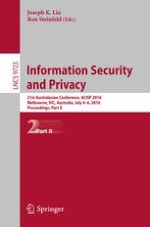The two-volume set LNCS 9722 and LNCS 9723 constitutes the refereed proceedings of the 21st Australasian Conference on Information Security and Privacy, ACISP 2016, held in Melbourne, VIC, Australia, in July 2016.
The 52 revised full and 8 short papers presented together with 6 invited papers in this double volume were carefully reviewed and selected from 176 submissions. The papers of Part I (LNCS 9722) are organized in topical sections on National Security Infrastructure; Social Network Security; Bitcoin Security; Statistical Privacy; Network Security; Smart City Security; Digital Forensics; Lightweight Security; Secure Batch Processing; Pseudo Random/One-Way Function; Cloud Storage Security; Password/QR Code Security; and Functional Encryption and Attribute-Based Cryptosystem. Part II (LNCS 9723) comprises topics such as Signature and Key Management; Public Key and Identity-Based Encryption; Searchable Encryption; Broadcast Encryption; Mathematical Primitives; Symmetric Cipher; Public Key and Identity-Based Encryption; Biometric Security; Digital Forensics; National Security Infrastructure; Mobile Security; Network Security; and Pseudo Random / One-Way Function.
